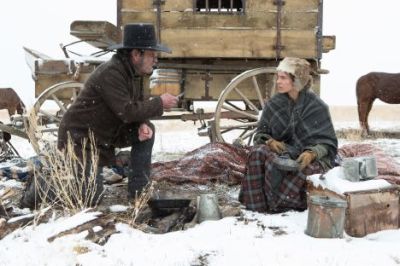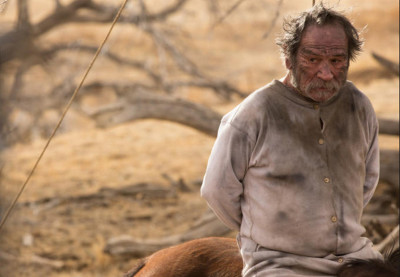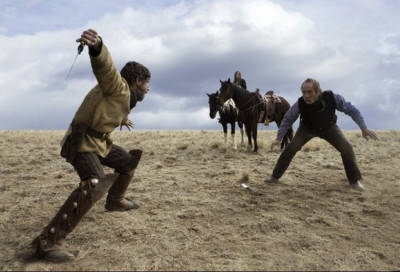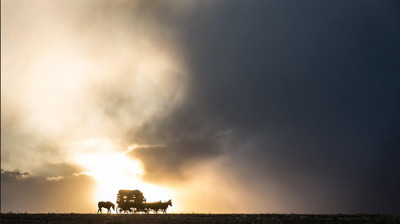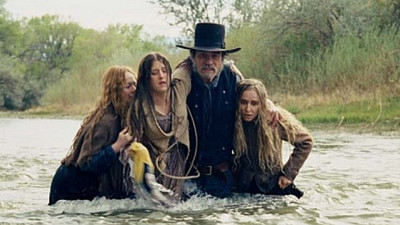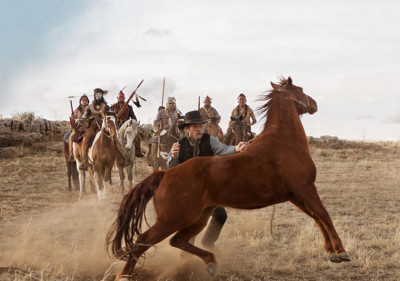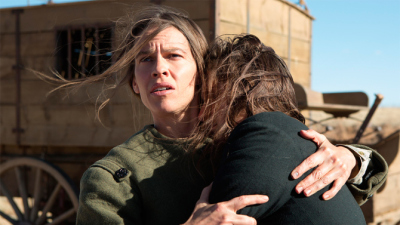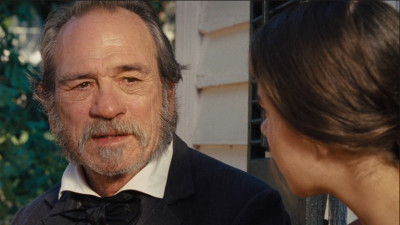In a word, THE HOMESMAN is captivating. Directed by Tommy Lee Jones and co-written by Jones, Kieran Fitzgerald and Wesley Oliver based on the novel by Glendon Swarthout, THE HOMESMAN captures a moment in history; a brief moment in the intersecting lives of 5 people, a slice of history with the beauty of simplicity, the grandeur of visual expanse with an intimate feel.
Hilary Swank dominates as a self-sufficient and independent unmarried woman in 1850 Nebraska. Pious, prim, hard-working, Mary Bee Cuddy has her own ranch and money in the bank, yet is desperate for a husband. Always wanting to do the right thing, the humane and godly thing, Mary Bee offers to take three of the local women east to Iowa. Each has been driven insane, either from marriage, motherhood or loss of a child and their husbands can’t deal with them. A kindly reverend and his wife have offered to get them care and help them get back east to their families, if someone can just bring the women to them. As none of the men in town will help, Mary Bee volunteers. But she can’t do it alone.
As luck would have it, Mary Bee meets George Briggs – a man literally hanging at the end of his rope – as she finds him still alive in a botched lynching. Somewhat of a scallywag, Briggs is enough of a man to be beholden to the woman who saved his life and agrees to accompany her in transporting her charges to Iowa. Of course, he will also collect $300 on journey’s end.
Mismatched from the start with each trying to be more defiant, independent and stubborn than the other, much of the journey is silent with little to no conversation. But with nothing but the creaking wagon wheels and whistle of the wind, sooner or later someone has to talk. And as they face the elements, the difficulties of caring for these helpless ill women, the threat of Indians, it seems that Mary Bee and Briggs are not that different and each is on their own journey for redemption or self-discovery.
Tommy Lee Jones is a gifted director with a strength for visual storytelling. There is a lovely lyricism to the lensing as it tells a story in and of itself, serving as a perfect complement to the minimalist styling of the film as a whole, creating a perfect tonal bandwidth. Thanks to some outstanding widescreen lensing in Galisteo, New Mexico (standing in for Nebraska and the plains) and elsewhere with the desert and prairie scenes, we feel how small and insignificant one person is in the face of the world and Mother Nature, while through the performances of Swank and Jones we see how tall one stands with conviction and determination. Every scene says something. There is nothing gratuitous in the construct of “The Homesman.” Jones knows how to tell a story visually – through cinematographic excellence and calculated pacing – as well as with character and story.
Myself well familiar with cinematographer Rodrigo Prieto’s work, I believe Jones made a wise choice selecting him as cinematographer on “The Homesman”. Shooting daylight scenes with film and nighttime digitally with the Sony F-55 and then giving filmic texture in post-production so the imagery would match, Prieto creates an elegantly expansive, yet commandingly quiet, visual palette yet gives us an intimate connection with not only the land, but the people. It’s a dichotomous emotional bandwidth that is so difficult and rare, yet Jones and Prieto together do just that. Some of the “Mary Bee lost in the dark on a horse” scenes are breathtaking with inky blues, stark white and real saturation of darkening twilight colors. A flaming hotel burning to the ground in the dark of night in a completely barren undeveloped stretch of land is hollowing, yet emotionally fulfilling and satisfying. And then the lightness of visual texture as the group reaches the river banks near Iowa (a beautiful Lumpkin, Georgia and Hannahatchee Creek substituting for Iowa) where sunlight softens, greenery abounds and the entire mood lifts and shifts, now being treated with a light touch, a light lens, some soft sunlight, but also more intimate framing.
Jones and Prieto are masterful with the framing. As the journey of Mary Bee and Briggs commences in Nebraska, the horizon is used as the eyeline. Opening with wide shots of the plains, everything revolves around a seemingly still camera with the wagon and our travelers lensed at a distance, at horizon level with blue sky or sunset behind them creating stirring backlit imagery. Jones brilliantly uses widescreen as a metaphor. Just watch how wide the shots are as Mary Bee and Briggs embark on their journey, but as the characters connect, as Mary Bee and Briggs become closer, as the three women settle down and become a bit “tamer”, the camera incrementally gets tighter. None of the five are as insignificant as they thought or as many treated them at the outset of the journey. They are not “specks” on the prairie. As the group reaches Iowa (aka Lumpkin, Georgia and the Hannahatchee Creek), framing is softer and more fluid with a hand held sensibility in certain moments. So important to the overall emotion and story, the result is beyond compelling.
Describing his considerations for the emotional journey in terms of his visual palette, Jones notes, “[I]t’s a journey eastward, and the destination looked a lot different than the origin. I got really tired of trying to figure out how we were going to make Galisteo, New Mexico look like bosky woods. We thought of everything and all manner of computer-generated imaging and phony trees and it just didn’t work.” Thanks to some wonderful location scouting, Jones found Lumpkin, Georgia and the living history community of Westville. “We were very lucky to find Lumpkin, Georgia where some man with a considerable amount of discretionary income tried to buy every 19th century house in Georgia and Alabama, and he brought it and made it a little town and it was perfectly suited to our purposes. We were very, very lucky to find that facility. Because of the contrast between Nebraska and Iowa, we wanted the end of the journey to look and feel a lot different than the beginning.”
Attention to detail of story and visuals is also beautifully depicted with a scene in which Mary Bee is singing and craving a return to culture. Described by Jones as “a beautiful scene”, what makes it so powerful is that the camera is on 180 degree dolly track with the camera always moving. “There is always something happening. As the camera moves, that candle gets behind her head and backlights her hair beautifully.” Using actual lit candles, Jones explains, “If you’re moving this camera around and suddenly a candle that you see originally here [indicating] winds up being an angelic backlight, it makes a halo. That was the trick I was trying to play. It looks static but it’s always moving. You can’t take your eyes off of her in that singing scene.”
Truly impressive, however, are the characters and the performances. While, as Jones notes, the Swarthout book “offered us a chance to make a screenplay that had some originality to it. . .[and] we are desperately clawing for originality”, he wasn’t afraid to add a bit of self-deprecation to his role, adding some lighter moments with his take on Briggs; a nice balance to some of the deeper thematic commentary throughout the film. A nighttime seduction of Briggs by Mary Bee is as tender and soft as I have ever seen Jones play, while the burning of a new hotel business venture serves almost as a hammering catharsis for Briggs’ unspoken anger at life.
Finding “The Homesman” to be “not just a period piece” but a story that “really parallels everyday life for a lot of people” and particularly for women trying to “find[ing] a man to walk shoulder to shoulder with”, as Mary Bee, Hilary Swank is restrained strength and grit. Swank gives Mary Bee this great practicality and bravura facade, but you can tell she is socially awkward with “less refined folk” and doesn’t quite know how to open up. Describing her as “a woman who has manners and morals and values, and she wants to do the right thing just for the sake of doing the right thing” there are key moments where manners start to falter a bit and Mary Bee starts to clinically open up and talk about her life to Briggs in which Swank adds some great facial nuance that speaks volumes. For Swank, “Mary Bee goes where angels fear to tread. All these valiant attributes to her, there’s still an underlying need for love.”
Supporting cast is outstanding. James Spader is a delicious pompous ass as Aloysius Duffy. John Lithgow has a little mystery going as Reverend Dowd while Meryl Streep is charming. Barry Corbin adds an authentic bit Hollywood western to the mix! And then the three women – Sonja Richter scared the hell out of me with her portrayal of Gro Svendsen while Miranda Otto and Grace Gummer create visual interest with no dialogue. But beyond that, the construct of the story and Jones giving us some flashbacks of each woman’s story and what they remembered, what tortured and tormented them, we see glimpses of the descent into insanity…..and the insensitivity of the men in their lives and their contribution to each women’s condition. Great commentary on the societal mindset of the day as well.
Production design and authenticity as a period piece of the day, not to mention costuming, excels. Applause to supervising sound editor David Bach and his team for the sound design. Every whistle of the wind, creek of the wagon wheel, foot on the dirt, babble of the creek, bird call, the horse and mule hooves, the crackle of fire or the thwack sound blankets make when you shake them out in folding…. and the various textures within each, are magnificently captured.
THE HOMESMAN – a masterful, fully sensory experience filled with visual majesty, immersing us in the life and lives of the time.
Directed by Tommy Lee Jones
Written by Tommy Lee Jones, Kieran Fitzgerald and Wesley Oliver based on the novel by Glendon Swarthout
Cast: Tommy Lee Jones, Hilary Swank, Grace Gummer, Miranda Otto, Sonja Richter, Barry Corbin, William Fichtner, James Spader, John Lithgow, Hailee Steinfeld and Meryl Streep

